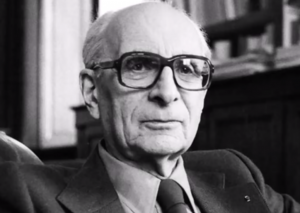Biography of an Extraordinary Anthropologist: Claude Lévi-Strauss

Claude Lévi-Strauss is the father of modern anthropology and one of the most distinguished thinkers of the 20th century. He was the founder of structural anthropology, which changed the history of the discipline. This made him famous in the world of academics.
Although it may seem strange, Claude Lévi-Strauss’s dream was actually interplanetary. He mentioned on several occasions that his great fantasy was for humans to colonize space and move to the moon or perhaps Mars.
This man imagined humans building new civilizations there and forgetting about those who had stayed on Earth. He believed that those who stayed would revert to a wild state and he would be able to study them.
“The world began without man, and it will complete itself without him.”
-Claude Lévi-Strauss-
Françoise Héritier, his successor at the Collège de France, summarized his work by saying that he taught something fundamental about humanity. Cultures can sometimes be very different from each other.
That being said, Lévi-Strauss proved that the cognitive apparatus of humans is the same. As a result of this, the differences and universality are both fundamental in human beings.

The beginnings of Claude Lévi-Strauss
Claude Lévi-Strauss’s birth in Brussels, Belgium, on November 28, 1908, was an accident. This is because his parents were French Jews who were traveling at the time.
His father was a portrait painter and his mother was a housewife. He was surrounded by a love of art, especially painting, music, and poetry.
When World War I began, he moved to Versailles with one of his grandfathers. His grandfather was a renowned rabbi. Claude Lévi-Strauss’s first contacts with the synagogue were cold and rigorous. As a result, he became indifferent to religion from a young age.
Instead, he became passionate about nature and showed a lot of interest in collecting rare and curious cultural artifacts. He was also intellectually sharp, even though he didn’t really stand out during his school years.
When he was a teen, he returned to Paris, where his family lived, and joined a socialist organization.
From philosopher to ethnologist
Claude Lévi-Strauss initially decided to study law. However, in 1927, he changed his mind and changed his major to philosophy at Sorbonne University.
There, he met Jean-Paul Sartre and Simone de Beauvoir. He later confessed that philosophy both attracted and exasperated him, as he felt there were too much vanity and speculation in that field.
When he finished his studies, he began working as a middle school teacher. However, he didn’t feel comfortable in this profession; he didn’t see himself giving classes for the rest of his working life.
Everything changed when he got a call from Célestin Bouglé, director of the École normale supérieure (a prestigious graduate school) in Paris.
That moment marked a radical turn in his life. Bouglé asked him to travel to São Paulo on a university mission to become a professor of Sociology.
He arrived there in 1935. In 1939, he began to make ethnographic expeditions to Mato Grosso and the Amazon. This experience marked the beginning of his most important work: structural anthropology.

A man who lived a century
After his experiences in Brazil, Claude Lévi-Strauss began to propose new ideas, new methods, and great reflections. He later spent some time in the United States to escape Nazi persecution during the World War II. He established valuable intellectual contacts there and continued to flesh out his theories.
One of the culminating points of his career was the publication of Tristes Tropiques, which is widely considered to be one of the most important books of the 20th century. This book marked his passage to academic celebrity. He also wrote Race and History, Myth and Meaning: Cracking the Code of Culture, and the Mythology series.
Also, people say he was a distant man who didn’t accept flattery. According to legend, he was unable to write without lyrical music.
He died in 2009 at the age of 100, having received many awards and recognitions during his lifetime. His work divided the study of history from the study of anthropology. Thanks to him, new research in the field of anthropology developed into what it is today.
All cited sources were thoroughly reviewed by our team to ensure their quality, reliability, currency, and validity. The bibliography of this article was considered reliable and of academic or scientific accuracy.
Lévi-Strauss, C., & Florián, V. (1971). Conversación con Claude Lévi-Strauss. Ideas y Valores, 20(38-39), 57-68.
This text is provided for informational purposes only and does not replace consultation with a professional. If in doubt, consult your specialist.








